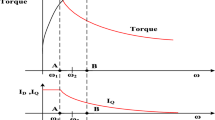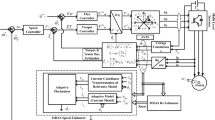Abstract
The permanent magnet assisted reluctance synchronous machine (PMA RSM) is a controlled object of multi-variable, nonlinearity and strong coupling. The fact that d-axis current can be controlled by d-axis voltage directly, same as the q-axis current, can not be realized even if the field current and torque current have been decoupled in the synchronous coordinates. A decoupling method for the electrical model is presented, which means the speed voltage and mutual inductance voltage are subtracted in the machine model proposed. Therefore the control of d- and q-axis components is changed to single-loop independent control system. Then a current controller is designed, which is applied to the current control of PMA RSM. The result from simulation shows that it is of high performance of dynamic and robustness.
Access this chapter
Tax calculation will be finalised at checkout
Purchases are for personal use only
Similar content being viewed by others
References
Lipo TA (1991) Synchronous reluctance machines-A viable alternative for AC drives. Electr Mach Power Sys 19(6):659–671
Matsuo T, Lipo TA (1994) Rotor design optimization of synchronous reluctance machine. IEEE Trans Energy Convers (2):359–365
Kamper MJ, Mackay AT (1995) Optimum control of the reluctance synchronous machine with cageless flux barrier rotor. SAIEE Trans 86(2):49–56
Germishuizen J, Van der Merwe FS, Van der Westhuizen K, Kamper MJ (2000) Performance comparison of reluctance synchronous and induction traction drives for electrical multiple units. IEEE IAS Conference (Rome), Oct 2000
Erashima M (1997) Novel motors and controllers for high-performance electric vehicle with four in wheel motors. IEEE Trans Iad Appl 44(1):28–38
Guglielmi P, Pastorelli M, Pellegrino G, Vagati A (2004) Position-sensorless control of permanent-magnet-assisted synchronous reluctance motor. IEEE Trans Ind Appl 40(2):615–622
Wildi T (2002) Electrical machines, drives, and power systems. Prentice Hall, Englewood Cliffs
Author information
Authors and Affiliations
Corresponding author
Editor information
Editors and Affiliations
Rights and permissions
Copyright information
© 2012 Springer-Verlag London Limited
About this paper
Cite this paper
Guo, Y., Wang, T., Ai, Yl. (2012). Study of Current Controller Design and Performance Based on PMA RSM Model Decoupling. In: Wang, X., Wang, F., Zhong, S. (eds) Electrical, Information Engineering and Mechatronics 2011. Lecture Notes in Electrical Engineering, vol 138. Springer, London. https://doi.org/10.1007/978-1-4471-2467-2_62
Download citation
DOI: https://doi.org/10.1007/978-1-4471-2467-2_62
Published:
Publisher Name: Springer, London
Print ISBN: 978-1-4471-2466-5
Online ISBN: 978-1-4471-2467-2
eBook Packages: EngineeringEngineering (R0)




